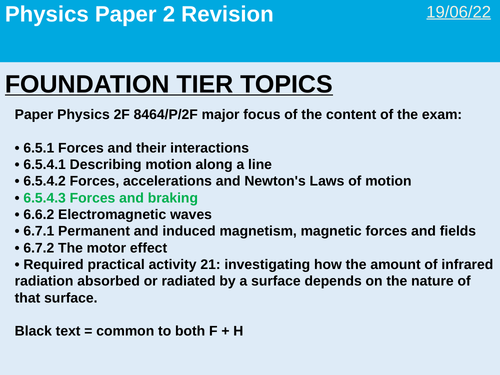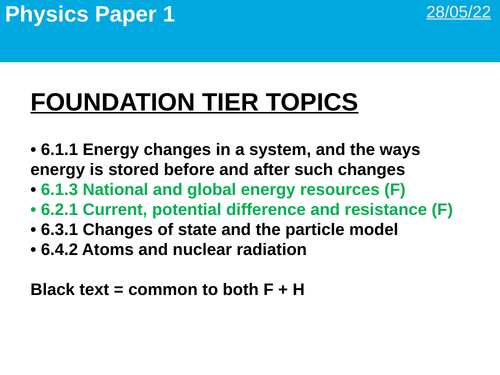32Uploads
22k+Views
33k+Downloads
Physics

AQA Combined Science Physics Paper 2 2022 Exam Major Focus Content Revision
Exam Major Focus Content (FOUNDATION)
• 6.5.1 Forces and their interactions
• 6.5.4.1 Describing motion along a line
• 6.5.4.2 Forces, accelerations and Newton’s Laws of motion
• 6.5.4.3 Forces and braking
• 6.6.2 Electromagnetic waves
• 6.7.1 Permanent and induced magnetism, magnetic forces and fields
• 6.7.2 The motor effect
Exam Major Focus Content (HIGHER)
• 6.5.1 Forces and their interactions
• 6.5.4.1 Describing motion along a line
• 6.5.4.2 Forces, accelerations and Newton’s Laws of motion
• 6.5.5 Momentum
• 6.6.2 Electromagnetic waves
• 6.7.2 The motor effect
• Required practical activity 21: investigating how the amount of infrared radiation absorbed or radiated by a surface depends on the nature of that surface.

AQA Combined Science Physics Paper 1 Exam Revision Powepoint
Covers: major exam focus content and RPAs 14 +16
Foundation Tier topics:
Energy changes in a system, and the ways energy is stored before and after such changes
National and global energy resources
Current, potential difference and resistance
Changes of state and the particle model
Atoms and nuclear radiation
Higher Tier topics:
Energy changes in a system, and the ways energy is stored before and after such changes
Energy transfers
Changes of state and the particle model
Particle model and pressure
Atoms and isotopes
Atoms and nuclear radiation
Required practical activity 14: an investigation to determine the specific heat capacity of one or more materials
Required practical activity 16: use circuit diagrams to construct appropriate circuits to investigate the I–V characteristics of a variety of circuit elements, including a filament lamp, a diode and a resistor at constant temperature.

Waves -7. End of Topic Revision Lesson and Questions
Knowledge organisers - Q &A’s
Student worksheet questions
Application Questions worksheet
Suitable for AQA, CIE, EDEXCEL, OCR Combined Science/ Physics

Waves - 6. RPA: Investigating Infrared Radiation
Aim
materials and apparatus
Identification of variables in the investigation
results table (with sample results)
analysis of results
conclusion
evaluation, suggestions for improvements
Knowledge recall questions
I do, we do, you do tasks
Knowledge recall quiz
Practical worksheet for Higher and Foundation students
Suitable for AQA, CIE, EDEXCEL, OCR Combined Science/ Physics

Waves - 5. EM waves: Uses and their Dangers
Radio waves: their production, properties and uses
EM waves: their uses, suitability and associated dangers
Knowledge recall questions
I do, we do, you do tasks
Application questions
Worksheet for Higher and Foundation students with answers
Suitable for AQA, CIE, EDEXCEL, OCR Combined Science/ Physics

Waves - 4. Wave Behaviour and Electromagnetic waves
Wave behaviour (HIGHER ONLY)
Description of electromagnetic (EM) waves with specific examples
EM waves Continuous spectrum – different types of radiation
Explanation of why an EM spectrum is produced
Wavelengths and frequency for the waves of the EM spectrum
Knowledge recall questions
I do, we do, you do tasks
Application questions
Worksheet for Higher and Foundation students with answers
Suitable for AQA, CIE, EDEXCEL, OCR Combined Science/ Physics

Waves - 3. Refraction
Definition of refraction
How refraction affects a wave
Definition of optical density
Drawing light ray diagrams
Refraction using wave front diagrams
Knowledge recall questions
Application questions, I do, you do, we do
Worksheet for Higher and Foundation students with answers
Suitable for AQA, CIE, EDEXCEL, OCR Combined Science/ Physics

Waves 2. RPA: Investigating Waves
Measuring the wave speed using a ripple tank, equipment list and method
sample results provided for the investigation
Calculating the wave speed using a string , equipment list and method
sample results provided for the investigation
Suggested improvements for the investigations
Suitable for AQA, CIE, EDEXCEL, OCR Combined Science/ Physics

Waves 1. Transverse and Longitudinal waves
Waves and energy transfer
Definitions of amplitude, frequency, wavelength, period and rest position
Different types of waves and their oscillations
Calculating Period of a wave
Calculating wave speed
Knowledge recall questions
Application questions, I do, you do, we do
Worksheet for Higher and Foundation students with answers
Suitable for AQA, CIE, EDEXCEL, OCR Combined Science/ Physics

12. Stopping Distances
• Definitions of: stopping distance, thinking distance, braking distance
• Factors that affect thinking and braking distance
• Explanation of how braking distance is affected by different factors
• Typical speeds and a breakdown of their stopping distances including thinking and braking distances
• Knowledge recall
• Application questions
• Differentiated worksheets for Higher and Foundation students with answers
• Suitable for AQA, CIE, EDEXCEL, OCR Combined Science/Physics

11. Inertia and Newton’s Third Law
Definition of inertia (Higher only)
Calculating inertial mass (Higher only)
Newton’s Third Law
Description and explanation of the forces involved
Application questions
Differentiated worksheets for Higher and Foundation students with answers
Suitable for AQA, CIE, EDEXCEL, OCR Combined Science/Physics

10. Newton’s First and Second Laws
• Explanations of Newton’s First and Second Laws
• Motion with respect to Newton’s First and Second Laws
• Relationship between Force, mass and acceleration (Newton’s Laws made simple)
• Application questions
• Worksheet for Higher and Foundation students with answers
• Suitable for AQA, CIE, EDEXCEL, OCR Combined Science/Physics

9. Velocity-Time Graphs and Terminal velocity
• Drawing and interpreting velocity-time graphs
• Calculating Acceleration and the distance travelled in a time period
• Factors affecting the speed of a moving object
• Definition of terminal velocity
• Factors that affect terminal velocity
• Application questions
• Worksheet for Higher and Foundation students with answers
• Suitable for AQA, CIE, EDEXCEL, OCR Combined Science/Physics

7. Distance-Time Graphs
drawing a distance-time graph
describing the motion of an object using a distance-time graph
calculating the speed of an object using a distance-time graph
explanation of the types of curves (horizontal, rising, descending)
Application questions
Worksheet for Higher and Foundation students with answers
Suitable for AQA, CIE, EDEXCEL, OCR Combined Science/Physics

5. Forces and Elasticity
Hooke’s Law
Definitions of elastic and inealstic deformation
Explanation of the relationship between extension and force
Explanation of Force/extension graphs
Required Practical with sample results
Application questions
Worksheet for Higher and Foundation students with answers
Suitable for AQA, CIE, EDEXCEL, OCR Combined Science/Physics

8. Speed, Velocity and Acceleration
Definitions of speed, velocity and acceleration
Calculating change in velocity
Displacement
Calculating acceleration
Explanation of the curve for acceleration
Constant Acceleration calculations
Application questions
Worksheet for Higher and Foundation students with answers
Suitable for AQA, CIE, EDEXCEL, OCR Combined Science/Physics

4. Calculating forces
Powerpoint lesson
Lesson worksheets (Higher and foundation with answers)
Working out a resultant force using scale drawings
An object at equilibrium
Resolving a force using a scale grid
model questions and application questions
Suitable for AQA, OCR, EDEXCEL, IGCSE specifications

3. Resultant Forces and Work done
Powerpoint lesson
Lesson worksheets (Higher and foundation with answers)
definition of resultant force
interpreting force diagrams
free body diagrams
definition of work done
application of work done equation
Suitable for AQA, OCR, EDEXCEL, IGCSE specifications

2. Weight Mass and Gravity
Powerpoint Lesson and worksheets
Gravity
Definitions of weight, mass and gravity
Difference between weight and mass
Applying the equation for weight
Application Worksheet and plenary resource (wordsearch) are also included. Suitable for AQA, OCR, EDEXCEL, IGCSE specifications

1. Quantities and forces
Introductory lesson to Forces. Topics covered include:
• Definitions of scalar and vector quantities and the differences between them
• Examples of Scalar and vector quantities
• Types of forces – contact and non-contact
• Student tasks included
• Differentiated work sheets for higher and foundation tier students
• Knowledge recall
• Look, cover, write check
• Application questions
• Modelled answers
suitable to use for a variety of specifications




















